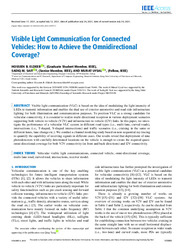Visible light communication for connected vehicles: How to achieve the omnidirectional coverage?
| dc.contributor.author | Eldeeb, Hossıen Badr | |
| dc.contributor.author | Sait, S. M. | |
| dc.contributor.author | Uysal, Murat | |
| dc.date.accessioned | 2022-10-25T10:08:44Z | |
| dc.date.available | 2022-10-25T10:08:44Z | |
| dc.date.issued | 2021 | |
| dc.identifier.issn | 2169-3536 | en_US |
| dc.identifier.uri | http://hdl.handle.net/10679/7925 | |
| dc.identifier.uri | https://ieeexplore.ieee.org/document/9495818 | |
| dc.description.abstract | Visible light communication (VLC) is based on the idea of modulating the light intensity of LEDs to transmit information and enables the dual use of exterior automotive and road side infrastructure lighting for both illumination and communication purposes. To position VLC as a strong candidate for vehicular connectivity, it is essential to realize multi-directional reception in various deployment scenarios supporting both vehicle-to-vehicle (V2V) and infrastructure-to-vehicle (I2V) links. In this paper, we investigate the performance of a vehicular VLC system in different road types (i.e., multi-lane, curved roads), intersections (i.e., T-shaped, Y-shaped intersections) and traffic scenarios (i.e., cruising in the same or different lanes, lane change etc.). We conduct a channel modeling study based on non-sequential ray tracing to quantify the capability of receiving signals in different cases. Our results reveal that deployment of nine photodetectors with carefully determined locations on the vehicle is enough to create the required quasi-omni-directional coverage for both V2V connectivity (in front and back directions) and I2V connectivity. | en_US |
| dc.description.sponsorship | King Fahd University of Petroleum and Minerals (KFUPM) ; TÜBİTAK ; European Union’s Horizon 2020 | |
| dc.language.iso | eng | en_US |
| dc.publisher | IEEE | en_US |
| dc.relation | info:eu-repo/grantAgreement/EC/H2020/76446 | |
| dc.relation | info:turkey/grantAgreement/TUBITAK/215E311 | |
| dc.relation.ispartof | IEEE Access | |
| dc.rights | Attribution 4.0 International | * |
| dc.rights | openAccess | |
| dc.rights.uri | http://creativecommons.org/licenses/by/4.0/ | * |
| dc.title | Visible light communication for connected vehicles: How to achieve the omnidirectional coverage? | en_US |
| dc.type | Article | en_US |
| dc.description.version | Publisher version | en_US |
| dc.peerreviewed | yes | en_US |
| dc.publicationstatus | Published | en_US |
| dc.contributor.department | Özyeğin University | |
| dc.contributor.authorID | (ORCID 0000-0001-5945-0813 & YÖK ID 124615) Uysal, Murat | |
| dc.contributor.authorID | (ORCID 0000-0001-7560-1124 & YÖK ID 285570) Eldeeb, Hossıen | |
| dc.contributor.ozuauthor | Eldeeb, Hossıen Badr | |
| dc.contributor.ozuauthor | Uysal, Murat | |
| dc.identifier.volume | 9 | en_US |
| dc.identifier.startpage | 103885 | en_US |
| dc.identifier.endpage | 103905 | en_US |
| dc.identifier.wos | WOS:000679526100001 | |
| dc.identifier.doi | 10.1109/ACCESS.2021.3099772 | en_US |
| dc.subject.keywords | Connected vehicle | en_US |
| dc.subject.keywords | Curved road | en_US |
| dc.subject.keywords | Intersections | en_US |
| dc.subject.keywords | Multi-lane road | en_US |
| dc.subject.keywords | Omni-directional coverage | en_US |
| dc.subject.keywords | Receiver model | en_US |
| dc.subject.keywords | Vehicular visible light communications | en_US |
| dc.identifier.scopus | SCOPUS:2-s2.0-85111982746 | |
| dc.relation.publicationcategory | Article - International Refereed Journal - Institutional Academic Staff |
Files in this item
This item appears in the following Collection(s)
Share this page




